
Chipmunks are small, striped rodents of Sciuridae, the squirrel family; specifically, they are ground squirrels (Marmotini). Chipmunks are found in North America, with the exception of the Siberian chipmunk which is found primarily in Asia.
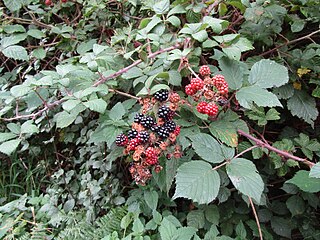
Rubus is a large and diverse genus of flowering plants in the rose family, Rosaceae, subfamily Rosoideae, with over 1,350 species, commonly known as brambles.

Mockingbirds are a group of New World passerine birds from the family Mimidae. They are best known for the habit of some species mimicking the songs of other birds and the sounds of insects and amphibians, often loudly and in rapid succession and for being extremely territorial when raising hatchlings. Studies have shown the ability of some species to identify individual humans and treat them differently based on learned threat assessments.

The dickcissel is a small seed-eating migratory bird in the family Cardinalidae. It breeds on the prairie grasslands of the Midwestern United States and winters in Central America, northern Colombia, and northern Venezuela. It is the only member of the genus Spiza, though some sources list another supposedly extinct species.

The black-throated gray warbler or black-throated grey warbler is a passerine bird of the New World warbler family Parulidae. It is 13 cm (5.1 in) long and has gray and white plumage with black markings. The male has the bold black throat of its name, and black stripes on its head, as well as black streaks on its flanks; the female is a paler version of the male, with a white throat and less distinct black markings on the flanks and wings. It breeds in western North America from British Columbia to New Mexico, and winters in Mexico and the southwestern United States. The habitats it prefers are coniferous and mixed forests and scrubland, especially those with pinyon pines, junipers, sagebrush, and oaks. Its nest is an open cup of plant fibers lined with feathers, built a few metres from the ground in the branches of a tree or shrub. Three to five eggs are laid, and young are fed by both parents. Common in its breeding range, it does not seem to be seriously threatened by human activities, unlike many migratory warblers.
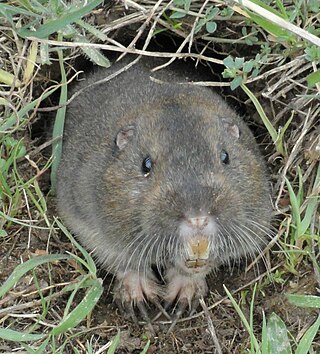
Pocket gophers, commonly referred to simply as gophers, are burrowing rodents of the family Geomyidae. The roughly 41 species are all endemic to North and Central America. They are commonly known for their extensive tunneling activities and their ability to destroy farms and gardens.
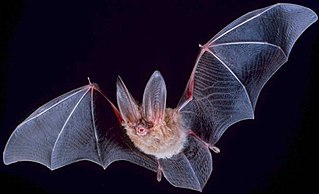
The genus Corynorhinus consists of the big-eared bats, or American long-eared bats. Only three species occur in the genus, all occurring in North America. Members of this group were previously in the genus Plecotus, the long-eared bats, and were also then called lump-nosed bats. Populations of these species are generally uncommon and declining. Two subspecies, the Virginia big-eared bat and the Ozark big-eared bat are federally endangered.

The genus Cathartes includes medium-sized to large carrion-feeding birds in the New World vulture (Cathartidae) family. The three extant species currently classified in this genus occur widely in the Americas. There is one extinct species known from the Quaternary of Cuba.

Townsend's vole is a species of rodent in the family Cricetidae, the sister species of M. canicaudus. It is found in temperate grasslands of British Columbia in Canada and in the states of Washington and Oregon in the United States.

The Philippine bulbul is a songbird species in the bulbul family, Pycnonotidae.

The Siskiyou chipmunk is a species of rodent in the family Sciuridae. It is endemic to northern California and central Oregon in the United States.

Scapanus is a genus of moles in the family Talpidae. They live in North America from west of the Rockies south to Baja California del Norte, and north to British Columbia, wherever conditions permit a mole population; that is to say, apart from the most sandy, rocky, or developed places. As they are one genus, they are very closely related, but as species, they rarely if ever interbreed successfully.

Sarcophaga is a genus of true flies and the type genus of the flesh-fly family (Sarcophagidae). The members of this cosmopolitan genus are frequently known as common flesh flies. There are more than 1000 species in Sarcophaga.
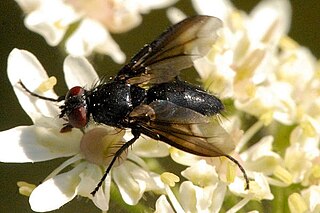
Voriini is a tribe of flies in the family Tachinidae. More junior homonyms exist of Wagneria than any other animal genus name.

Dexiinae is a subfamily of flies in the family Tachinidae.

Exoristinae is a subfamily of flies in the family Tachinidae. Most species are parasitoids of caterpillars.
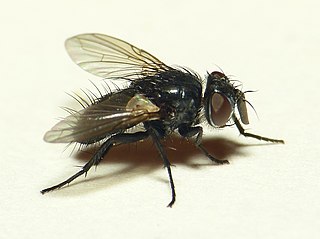
Blondeliini is a tribe of parasitic flies in the family Tachinidae. Larvae are parasitoids of other insects, mostly beetles and caterpillars. Although nearly cosmopolitan, its greatest diversity is in the New World and especially in South America.
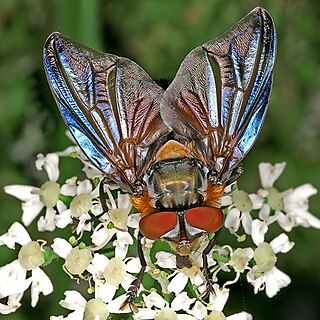
Phasiinae is a subfamily of flies in the family Tachinidae. Except for the small tribe Strongygastrini members of this subfamily attack only Heteroptera.
Kettlotrechus is a genus in the ground beetle family Carabidae. There are about five described species in Kettlotrechus, found in New Zealand.

Tachininae is a subfamily of flies in the family Tachinidae.

















